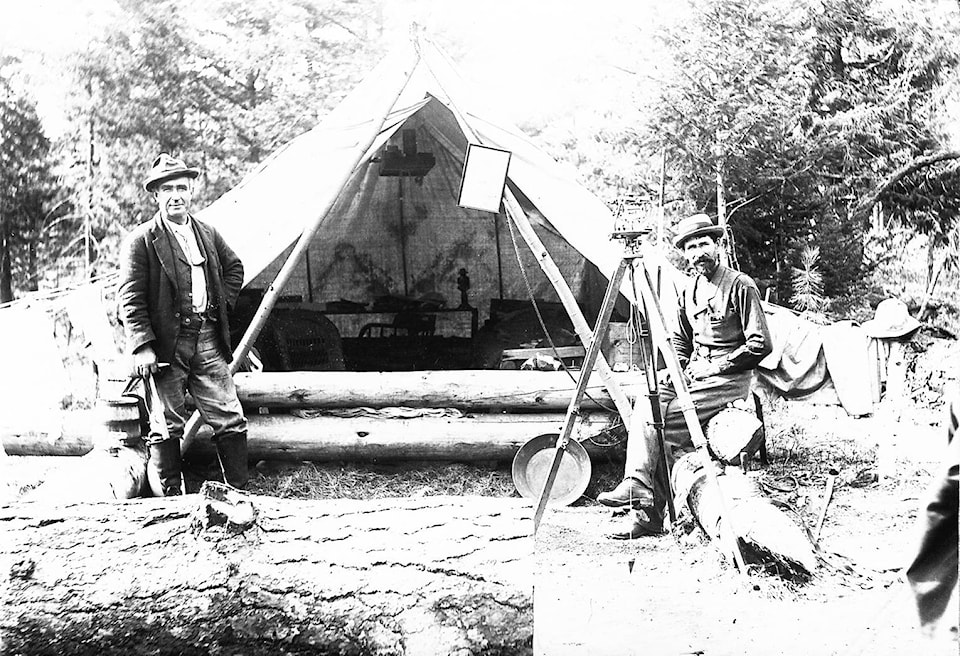By Roland Neeve
Anxious to get his letter to the premier quickly, he [Robert Lee] hiked from his Camp #9 out to Clearwater and the nearest post office. That journey of 60 km along the survey trail probably took six days return, which would account for no work being done between July 24 and 30, [1913].
In his methodical manner, he resumed his surveys west from his camp, recording the falls on Lot #3195 on July 31. His mundane notes say, “The north 30 acres rock cliffs 500 ft high, the remainder dead and fallen timber, dense small fir and spruce with surface level sandy clay soil.”
There was no mention of the falls, which might have been considered a negative for homesteading. Less than three weeks later, on August 11, Lee received an answer, an amazing feat of communication, considering his remote camp and that he was addressing a politician.
However, Premier McBride’s response was curt, consisting of only one sentence:
Dear Mr. Lee:
I am much obliged for your letter of July 24th and would suggest that you call the falls you mention after the Venerable Hon. J.S. Helmcken, whose name I believe has not been connected with anything on the mainland and who desires to have his name preserved in the geography of B.C., for which he has done so much.
Yours very truly,
[R. McBRIDE]
Lee’s October 1913 map of the Murtle Plateau accordingly indicated the position of Helmcken Falls and, on his 1914 map, the name and a height of 450 feet are written in.
The “venerable honourable” gentleman for whom Helmcken Falls was named, John Sebastian Helmcken, was born in London, England, in 1824. Medically trained, he was appointed surgeon for the Hudson’s Bay Company on Vancouver Island and arrived in Victoria in 1850.
Dr. Helmcken was elected a member of the first House of Assembly of Vancouver Island in 1856 and also served as Speaker until 1866, when Vancouver Island and the mainland united.
Then he became a Member of the Legislative Council of British Columbia and, three years later, a Member of the Executive Council as well. Dr. Helmcken’s final political act was in 1870, when he was one of three delegates from British Columbia who travelled to Ottawa (no easy feat in the years before the Canadian Pacific Railway) to negotiate the terms of Confederation.
He then retired to private practice in Victoria and lived there until his death in 1920 at the age of 96. He never saw the falls named for him. His stately home in Victoria is now part of the Royal B.C. Museum; other place names that honour him are streets in Vancouver and Victoria, and Helmcken Island north of Campbell River.
Lee completed his survey on schedule at the end of 1914. He did an astounding job. Imagine pulling 100 foot long chains through the dense forests of Wells Gray, fighting the bugs, wading through swamps on the survey lines, and fording rivers.
Many of his stone mounds and a few posts marking lot corners have survived to the present. Lee and his assistants obviously made an important contribution to knowledge about agricultural lands in the Thompson watershed.
It is truly remarkable that, with modern survey methods including GPS, his corners have been found to be out by mere inches.
Ironically, after his years of tramping through difficult wilderness terrain, Lee died of injuries sustained from a fall in his home. He was 76. His funeral, on February 10, 1935, was attended by members of the Kamloops City Council, scores of civic and provincial officials, and many Kamloops citizens.
Lee’s daughter, Edith Rattray, wrote about her father as follows:
Unlike most of his profession, my father did not find any romance about surveying in the early days of British Columbia. He denied there was any excitement on the pack-trails from the Kootenays to the Cariboo, not even running the white-water on the Columbia. It was all just work to him. However, he really seemed to enjoy his discovery of Helmcken Falls and I wish [this could be] emphasized as a little memorial to that brilliantly clever, taciturn, unhappy man - my father - who worked so hard, so conscientiously and got so little pleasure from it all.
Lee Road in Kamloops (only three blocks long) is named for Lee, but so far nothing in Wells Gray Park or the Clearwater Valley recalls the accomplishments of this amazing man.
The 100th anniversary celebration of Lee’s discovery of Helmcken Falls was held on July 24, 2013, at the Upper Clearwater Hall. It was attended by a large group of Clearwater and Upper Clearwater residents and tourists.
Roland Neave gave a talk about Robert Lee, then the group hiked the trail along the Murtle River to the brink of Helmcken Falls, stopping at Camp #9 and retracing Lee’s footsteps of 100 years earlier.
